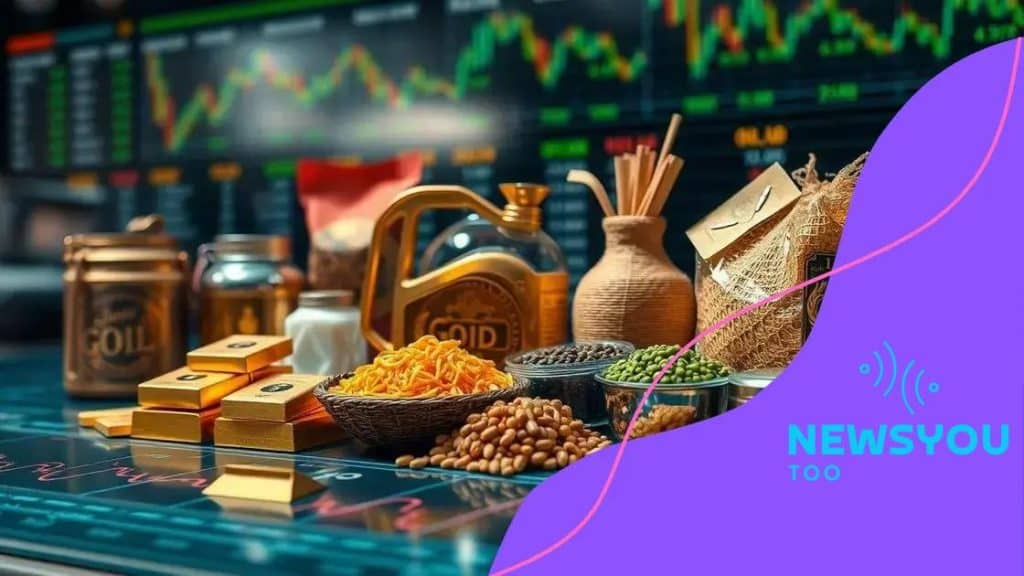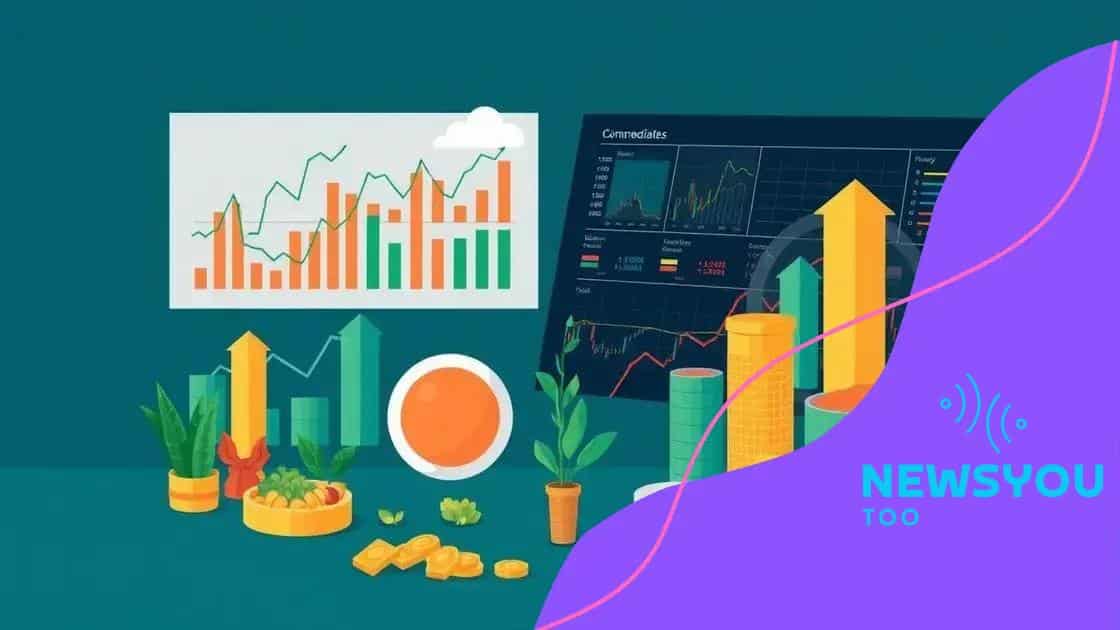What to know about investing in commodities

Anúncios
Investing in commodities involves understanding various types, market trends, and risks while employing strategies like diversification and research to maximize potential returns and manage volatility.
What to know about investing in commodities can seem daunting at first. But with the right insights, you can turn these natural resources into profitable opportunities. Are you ready to explore this exciting market?
Anúncios
Understanding the basics of commodities investment
Understanding the basics of commodities investment is crucial for anyone looking to diversify their investment portfolio. Commodities are often classified into two main categories: hard commodities, which are natural resources extracted from the earth, such as oil and gold, and soft commodities, which are agricultural products like wheat and coffee.
To start, it’s important to recognize what influences the prices of these commodities. Factors such as supply and demand, geopolitical stability, and market trends play significant roles. Understanding these factors can enhance your ability to make informed decisions when investing.
Types of Commodities
There are several types of commodities you can invest in:
Anúncios
- Energy commodities: Includes oil and gas.
- Precious metals: Such as gold and silver.
- Agricultural commodities: Includes corn, soybeans, and coffee.
- Industrial metals: Such as copper and aluminum.
Each of these categories offers different opportunities and risks. For instance, while investing in precious metals like gold can be a good hedge against inflation, energy commodities often fluctuate due to geopolitical events.
How to Invest
Investing in commodities can be done in various ways, including:
- Physical commodities: Purchasing actual goods, such as gold coins.
- Commodity ETFs: Exchange-traded funds that track commodity prices.
- Futures contracts: Agreements to buy or sell a commodity at a predetermined price in the future.
Each method has its own set of advantages and shareholders should choose based on their risk tolerance and investment strategy. It’s essential to research and analyze the market trends before committing your funds. For new investors, starting with ETFs can be less daunting than trading futures.
As you delve deeper into the world of commodities, you’ll find that managing risks is vital. Tools such as stop-loss orders can help protect your investments during volatile market conditions. Understanding market indicators and keeping abreast of news related to your commodities can also make a significant difference in your investing journey.
Types of commodities to consider

When exploring the types of commodities to consider, it is essential to understand the distinctions between them. Commodities can be divided into two main categories: hard commodities and soft commodities. Hard commodities are natural resources that are mined or extracted, while soft commodities are agricultural products or livestock.
Hard Commodities
Hard commodities include valuable resources that can be traded on the market. Some examples are:
- Crude oil: Often considered the most traded commodity;
- Gold: A stable asset and hedge against inflation;
- Natural gas: Essential for energy production;
- Metal ores: Such as copper and aluminum, used in manufacturing.
Investing in hard commodities can be beneficial for those looking to hedge against market volatility. Their prices typically fluctuate based on supply and demand, geopolitical events, and global economic conditions.
Soft Commodities
On the other hand, soft commodities usually come from agricultural production. Here are some notable examples:
- Corn: Vital for food production and biofuels;
- Coffee: Market demand significantly influences prices;
- Soybeans: Widely used for animal feed and oil;
- Wheat: A staple grain for many countries.
Soft commodities are also susceptible to weather conditions, seasons, and global demand shifts. Understanding these factors can help enhance your investment strategy.
Incorporating both hard and soft commodities in your portfolio allows for diversification and can reduce risks associated with volatility in specific markets. Investors should analyze trends and market conditions when choosing which commodities to invest in.
Market trends affecting commodities
Market trends affecting commodities can significantly influence your investment decisions. Understanding these trends not only helps predict price fluctuations but also aids in strategizing your investments. Several factors play a crucial role in shaping these trends.
Supply and Demand
The basic economic principle of supply and demand is often the primary driver of commodity prices. When demand for a commodity rises and supply cannot keep up, prices tend to increase. Conversely, if there’s an oversupply, prices may drop. For instance, if there is a drought affecting wheat production, the supply decreases, leading to higher prices.
Geopolitical Events
Geopolitical tensions can also have a dramatic impact on the commodities market. Conflicts, trade disputes, and sanctions can disrupt supply chains, causing prices to spike. For example, political instability in oil-producing regions can lead to concerns over oil supply, driving up crude oil prices.
Global Economic Conditions
The global economy also plays a vital role in commodities pricing. Economic growth in countries like China can boost demand for industrial metals and energy commodities. Conversely, a recession might lead to decreased demand, dropping prices. Understanding economic indicators such as GDP growth rates can help investors anticipate market movements.
Currency Fluctuations
Since many commodities are traded in US dollars, fluctuations in the dollar’s value can affect commodity prices. A weaker dollar makes commodities cheaper for foreign buyers, potentially increasing demand and raising prices. Investors should keep a close eye on currency trends when trading commodities.
Recognizing and analyzing these market trends is essential for successful commodities investment. Staying informed about global events and economic outlooks can help you make effective investment decisions.
Strategies for successful commodity investment

To achieve success in commodity investment, it is crucial to implement effective strategies. The commodities market can be unpredictable, but with the right approach, you can increase your chances of making profitable investments. Here are some key strategies that can help guide your actions.
Diversification
Diversification is one of the most important strategies for reducing risk. Instead of putting all your money into one type of commodity, consider investing across various categories. This can include:
- Energy commodities: Like oil and natural gas;
- Agricultural commodities: Such as wheat, corn, and coffee;
- Precious metals: Including gold and silver.
By diversifying your portfolio, you hedge against volatility in any single commodity category.
Research and Analysis
Staying informed is vital for successful commodity investment. Conduct thorough research on market trends, supply and demand factors, and geopolitical events that may affect prices. Regularly review economic indicators, as they can provide insights into potential price movements. Tools like technical analysis can help you identify patterns and trends.
Utilizing Futures Contracts
Futures contracts can be a powerful way to invest in commodities. These contracts allow you to agree to buy or sell a commodity at a predetermined price in the future. This strategy can help you leverage your investment while managing risk. However, it’s essential to understand the complexities and potential risks associated with futures trading.
Set Clear Goals
Establishing clear investment goals is crucial. Determine whether you’re looking for short-term profits or long-term growth. Setting specific, measurable objectives will help guide your investment choices and strategies. It can also provide insight into how much risk you’re willing to take on.
Additionally, consider implementing stop-loss orders to protect your investments. This tool can limit potential losses by automatically selling a commodity when it reaches a certain price.
Risks associated with investing in commodities
Investing in commodities can offer great opportunities, but it also comes with significant risks. Understanding these risks is crucial for anyone looking to enter this market. Commodities are subject to various unpredictable factors that can lead to financial loss, making awareness necessary for successful investing.
Price Volatility
One of the main risks associated with commodity investing is price volatility. Commodity prices can change rapidly due to supply and demand fluctuations, geopolitical tensions, and economic shifts. For example, extreme weather conditions can impact crop yields, causing prices to spike. This can create uncertainty for investors as they navigate sudden price changes.
Market Speculation
Another risk is market speculation. Commodities can attract speculators, which may cause prices to deviate from their real value based on genuine supply and demand. This speculation can lead to price bubbles and crashes, resulting in potentially severe losses for investors who do not act cautiously.
Geopolitical Risks
Geopolitical events can also greatly affect the commodities market. Political instability in oil-producing countries or trade disputes between nations can disrupt supply chains. Such disruptions often lead to increased prices or shortages, impacting your investments. Keeping an eye on global news is essential for anticipating these risks.
Liquidity Issues
Liquidity risk is another consideration when investing in commodities. Some commodities may not have enough buyers and sellers in the market, making it difficult to sell them without a significant price impact. Low liquidity can affect your ability to exit positions quickly, exposing you to heightened risk.
To mitigate these risks, investors should conduct thorough research and stay informed about market conditions. Being prepared for price fluctuations and maintaining a diversified portfolio can help manage the inherent risks of commodity investing.
FAQ – Common Questions About Investing in Commodities
What are commodities?
Commodities are basic goods that can be bought and sold, typically divided into categories like hard commodities (e.g., precious metals) and soft commodities (e.g., agricultural products).
What risks are associated with investing in commodities?
Investing in commodities carries risks such as price volatility, geopolitical factors, liquidity issues, and market speculation.
How can I diversify my commodity investments?
You can diversify by investing in a mix of different types of commodities, such as energy, agricultural, and precious metals, to reduce risk.
What strategies should I use for successful commodity investment?
Successful strategies include thorough research, setting clear goals, using futures contracts wisely, and maintaining a diversified portfolio.





